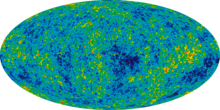 Dark matter is invisible. Based on the effect of gravitational lensing, a ring of dark matterhas been detected in this image of a galaxy cluster ( CL0024+17) and is represented in blue. [1]
Dark matter is a hypothetical kind of matter that cannot be seen with telescopes but accounts for most of the matter in the Universe. The existence and properties of dark matter are inferred from its gravitational effects on visible matter, radiation, and the large-scale structure of the Universe. It has not been detected directly, making it one of the greatest mysteries in modernastrophysics.
Dark matter neither emits nor absorbs light or any other electromagnetic radiation at any significant level. According to the Planck mission team, and based on the standard model of cosmology, the total mass–energy of the known universe contains 4.9% ordinary matter, 26.8% dark matter and 68.3% dark energy.[2][3] Thus, dark matter is estimated to constitute 84.5% of the total matter in the Universe, while dark energy plus dark matter constitute 95.1% of the total mass–energy content of the Universe.[4][5]
http://en.wikipedia.org/wiki/Dark_matter |








